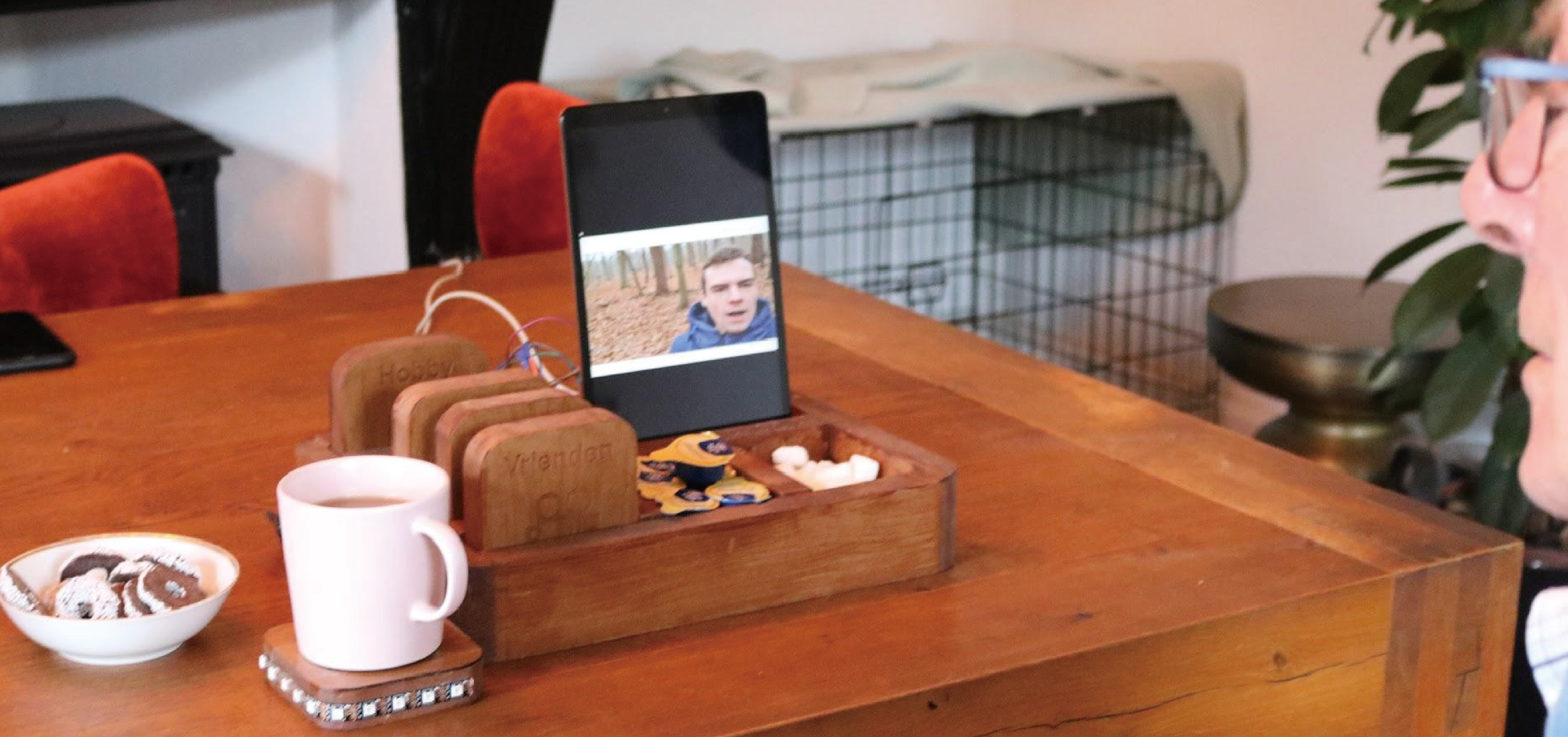
People with dementia who are living at home experience difficulties in participating in social interactions, while staying in contact with family members does add quality to their lived experience. Initiating communication can be challenging for family members since there is a natural disparity between the life patterns of people with dementia and family members.
CoasterChat is a tool that embeds digital communication in a daily coffee routine to support social relations between people with early-stage dementia and their family members. CoasterChat is a communication system that aims to asynchronously have both people with dementia and their family members engaged in a sharing moment during their coffee break. Apparent from this preliminary exploration is that technology operable without external support requires personalisation of digital guidance for the person with dementia. This provides an opportunity for technology to be embedded in existing asynchronous routines strengthening structure in the lives of people with dementia. Meanwhile, by integrating multimodal guidance into CoasterChat, we describe how people with dementia are guided seamlessly to use the artifact themselves. The benefit for the family members who engage in the interaction resides in the flexibility and accessibility of sending a message without immediate interaction.
The results reveal opportunities and consideration in design aimed at engaging people with dementia and family members in digital communication embedded in a coffee break routine.
| Time frame: | 09.2020 - 01.2021 |
| Client: | Archipel |
| Category: | Interaction Design, Design for Dementia |
| Development: | User and Society, Creativity and Aesthetics |
| Course: | Master Project 1 (Team Project) |
| Share: |
The design process consisted of three iterations before coming to the final design decisions and final usability test. For each of iteration, the study aims to create a person-centered solution and involve different stakeholders in the design process. All iterations included steps from the triple diamond (Google Ventures, n.d.) understand, define, sketch, decide, prototypes, and validate. For the first iteration, a survey was performed to understand the context and potential users and use this information to have a first brainstorm session. Secondly, a scenario for the demo day was created to discuss with peers and evaluate informally with studio silver experts with the aim of creating a final user test concept. Thirdly, a prototype was made and evaluated with the aim to receive feedback for a final concept.
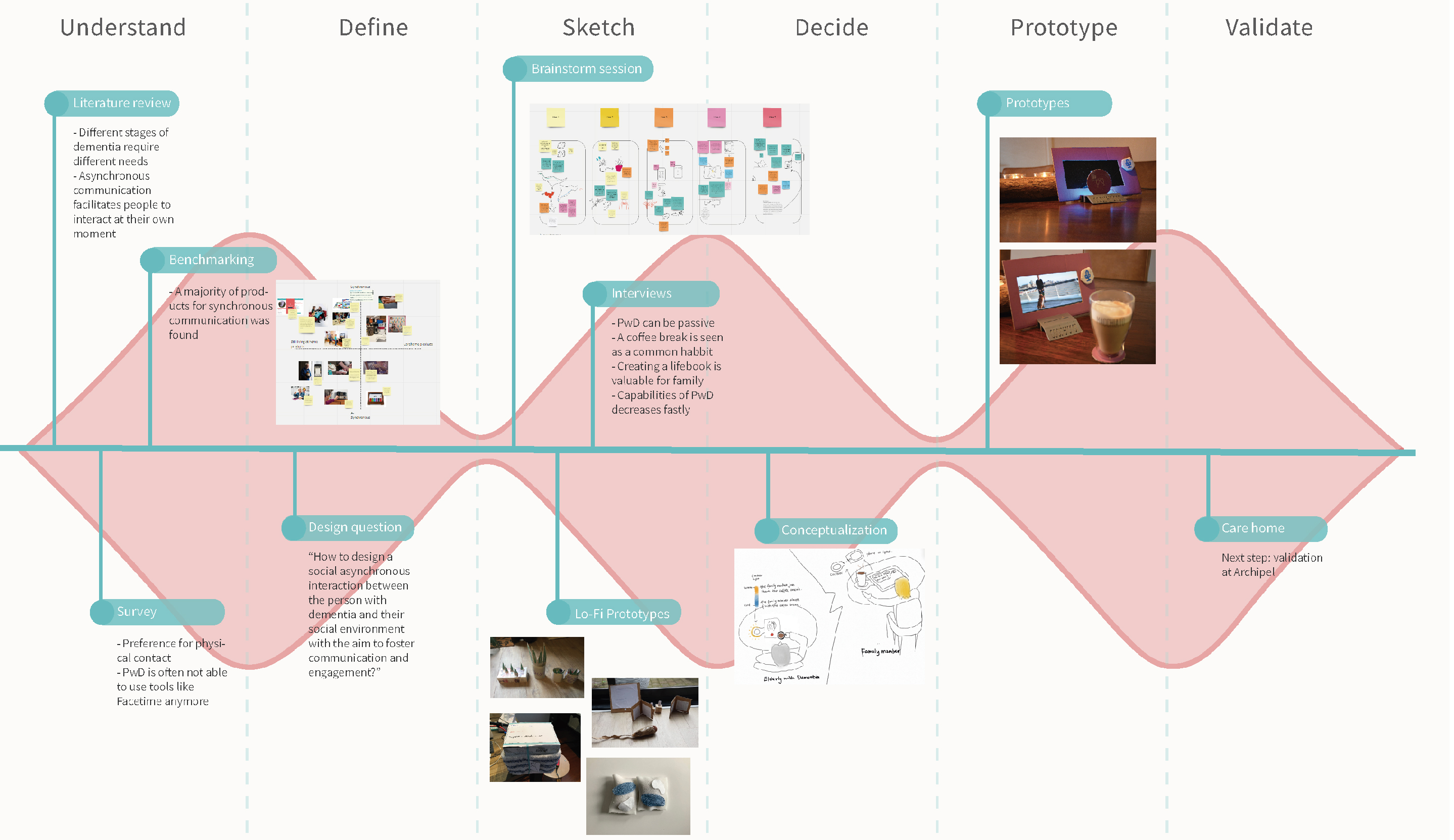
Three iterations on context exploratory stage
Using the feedback from the midterm demo day a new brainstorming session was held to improve the concept. For the family side, opportunities were discussed to make the interaction more playful. This concluded in a spinnable wheel integrated into the coaster, which makes it possible to determine a topic to talk about. These topics are represented in the dementia side prototype by different coasters in the coaster stand. Furthermore, the decision was made to design the coaster for home use, thus removing the keychain attachment. For the dementia side, based on the feedback, a focus was placed on making the concept more integrated in the coffee moment. This is why, for example, the possibility to put sugar and milk in the coaster stand was added. Additionally, for the dementia side more intuitive interaction was implemented with the function to more intuitively answer the message received from the family side. The decision for the evaluation is to use a physical microphone to talk into, since this is a recognizable object designed for recording. To make sure all different interactions were aligned, two scenarios were made, see Appendix X. Here we found, especially for the dementia side since people with dementia can find it difficult to interact with new technology, that every step needs some kind of assistance. For this reason, a combination of light, voice, and animation feedback was implemented as guidance. Finally, it was decided to not include the life story book in the current design, since this might add complexity to the first use of CoasterChat. This would be part of the personalization of the product in future design and research.

Mapping the possible interaction for the family member using the spinnable coaster

Mapping the possible interaction for the Person with Dementia using the CoasterChat
The validation aimed to explore the engagement with the prototype during a coffee break. The study took place at a daycare facility for people living with dementia. Additionally, for the family side, a separate validation was planned to receive feedback on the improved concept from family members of people with dementia during an online session. The first validation was conducted at a daycare facility (Pracht) for people with dementia. This location was chosen, since people who visit this place are in an early stage of dementia and still live at home. Thus, this matched our user group. In total, three visitors with early-stage dementia, and two caregivers participated in this study. All participants and the organization provided their written informed consent and were reminded that they could exit the study at any moment without having to provide a reason. The PwD was accompanied by a qualified caregiver at all times to evaluate if the PwD was still able and happy to participate in the study. See Figure 16 for the study set-up. The set-up was tested beforehand as a pilot study to make sure the set-up was optimal for this validation. Figure 16. Study set up validation on the dementia side The validation consisted of three elements: 1) exploration of the prototype, 2) interaction with the prototype, and 3) exit interview. During the exploration of the prototype, the participants were asked to communicate their thoughts regarding their first impression. During the study with the prototype, although fully functioning, the Wizard of Oz (Klemmer, 2000) method was used to ensure that the user test could proceed without any disruptions. Afterward, to gain additional insights into the interaction and prototype, exit interviews were conducted with both the PwD and the caregiver with the aim to reflect on the interaction.
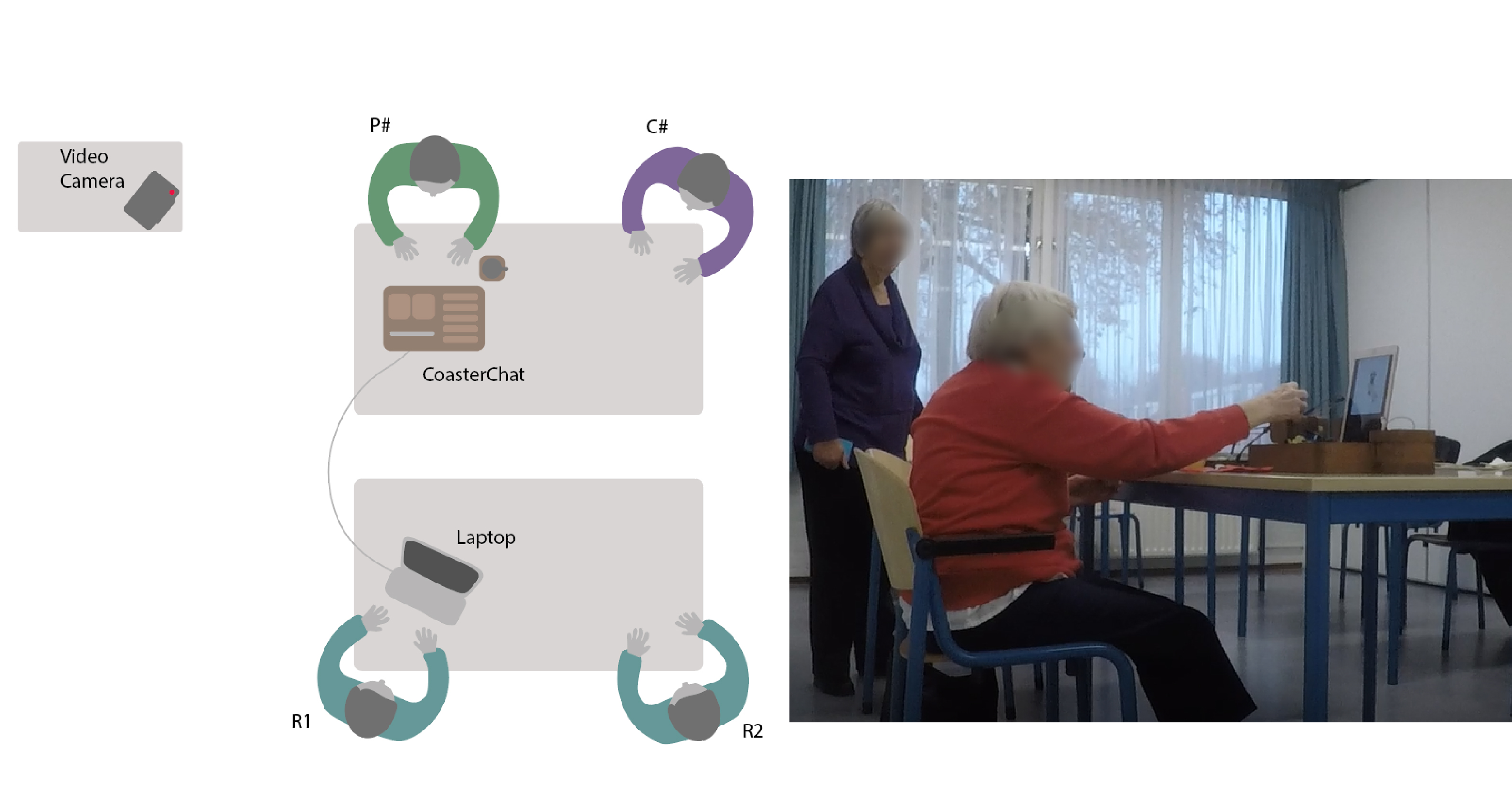
The experiment setup at Pracht with 3 groups of person with dementia and their caregivers.
The final design,CoasterChat, consists of two interconnected devices: a coaster stand for the PwD side, and a spinnable coaster for the family side. The family side coaster is connected to an app. The interaction is initialized by the family member. With the current access to technology we are constantly able to document our lives through the use of images, videos and social media . CoasterChat aims at providing a tool for the family members to share these activities, either from their own initiative or by suggesting a topic to discuss.
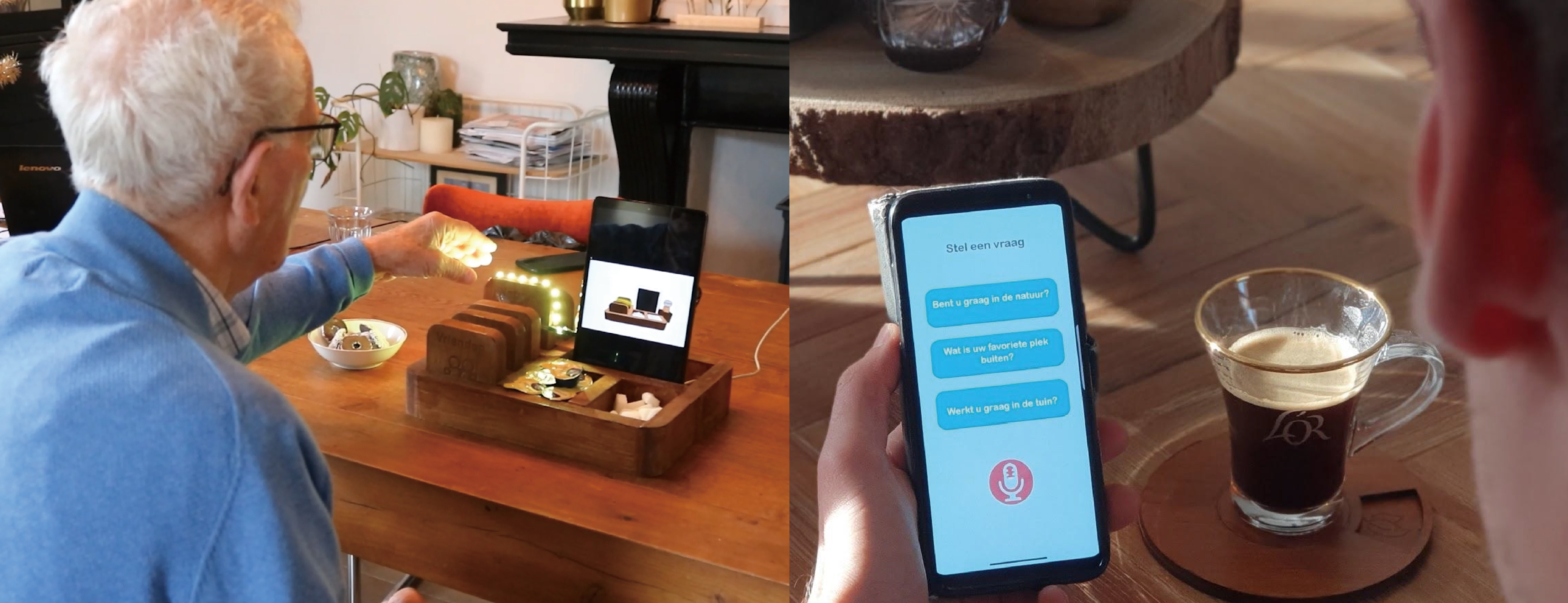
The interaction flow between the family member & Person with dementia (left: CoasterChat for Person with Dementia; right: Spinnable Coaster for the family member)
The spinnable coaster, aimed at notifying a family member it is their turn to share, combined with an app empowers the users to collaboratively partake in social sharing. Based on the story they share, the app will suggest a couple of questions related to that topic, which combined with the story gets sent to the PwD. The family side collaboratively partake in the activity, and based on availability distribute sending a message.
The device aimed at the PwD mimics a coaster stand, with in the front two compartments where cookies, milk and/or sugar can be placed. It consists of a complete system, with all interaction taking place within the device. The PwD gets notified that a new message is available through visual feedback (the coaster lights up & an animation starts to loop on the screen) and auditory feedback (On a customizable time interval the stand will notify the PwD a message has arrived, by playing a prerecorded personal family member voice). He/she will then be invited to a coffee/tea/drink break, where all required steps will be guided through visual and auditory feedback. After the PwD listens/watches the new message he/she will receive the question accompanied with the shared family member message. The system will immediately after the question is asked start a recording, which will be saved for the family member to listen to at his/her own optimal moment. We deliberately did not specify how the recorded message from the PwD side should be treated, as the user test showed that the users are creative enough to find their optimal use.
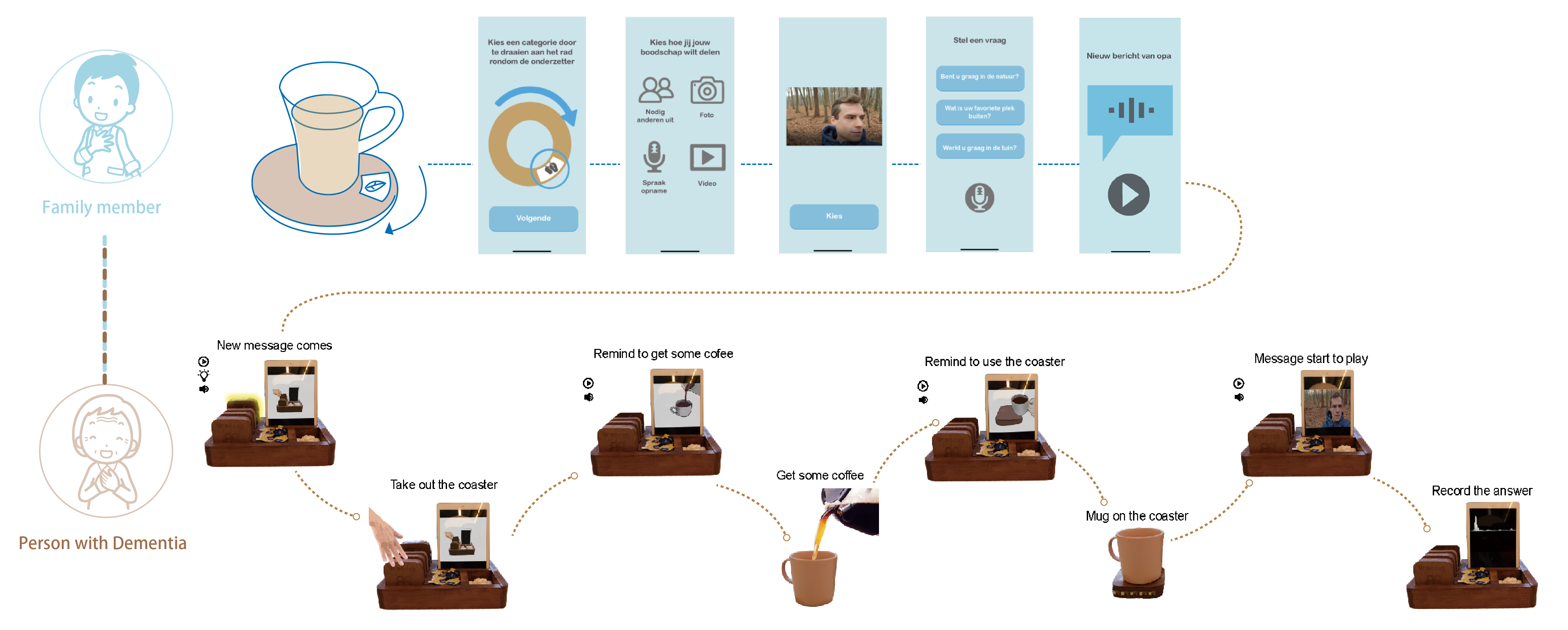
The interaction flow between the family member & Person with dementia
Asynchronous communication as a means of maintaining contact with a PwD
Asynchronous communication provides opportunities for connecting people in different stages of their lives with big differences in schedules. This allows for a potential delay in communication between different parties, and can add flexibility in different ways of living, which is also demonstrated in the disccusion with the potential user groups (U&S).
Social communication applied in daily routines
IIntegrating a communication activity into the routine of a coffee break adds structure and meaning to people with dementia's routines. In this regard, the form of C&A is critical for incorporating meaningful communication into the daily lives of PwD.
Technology assist in dementia
Multimodal interaction could be utilized as meaningful guidance and provides design room for personalization. The insights from the validation also strengthen the initiatives and autonomous behaviors of people with dementia.
Reflecting on team work collaboration
In this first project, I was primarily responsible for ideation and prototyping. Because the target group is so small, the challenge revealed that I wouldn't be able to conduct many user tests. However, my experiences working in a good team inspire me to come up with new ideas and express myself in terms of sharing and constructing relevant information.